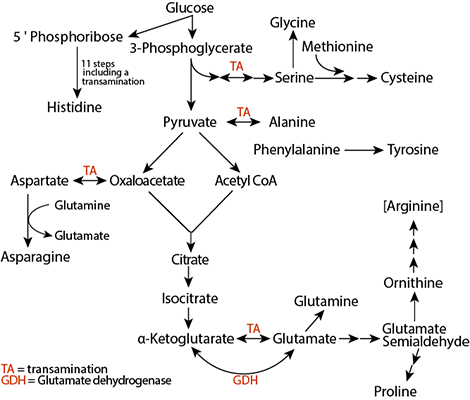SYNTHESIS & DEGRADATION OF AMINO ACIDS
-
The liver is the only tissue that has all the pathways of amino acid synthesis and degradation. During fasting, the carbon skeletons of amino acids produce glucose, ketone bodies, and CO2; in the fed state the liver can convert intermediates of amino acid metabolism to triacylglycerols; the fate of amino acid carbon skeletons, thus, parallels that of glucose and fatty acids
Synthesis of Non-Essential Amino Acids

Arginine is essential in children and adolescents but not in adults who have completed growth. The sulfer of cysteine is supplied by methionine; if methionine is limiting, cysteine becomes essential. Tyrosine is synthesized from phenylalanine; if phenylalanine is limiting, tyrosine becomes essential.
- Synthesis of the non-essential amino acids:
- Except for the synthesis of tyrosine from phenylalanine, carbon skeletons of the non-essential amino acids are produced from intermediates of glycolysis and the TCA cycle; four (serine, cysteine, glycine, alanine) from glycolytic intermediates, five (aspartate, asparagine, glutamic acid, glutamine, proline) from TCA cycle intermediates. Histidine is derived from glucose via the pentose phosphate pathway. Arginine is produced from ornithine by the urea cycle.
- Nitrogen is supplied as ammonia via transamination, using glutamic acid as the ammonia donor or, in the case of glutamic acid synthesis, by the reaction catalyzed by glutamate dehydrogenase.
- Amino acid degradation:
Amino Acid Degradation

- Most amino acids are deaminated to produce α-keto acids. In the fed state these α-keto acids can be used to synthesize triacylglycerols. In the fasted state they produce glucose, ketone bodies and CO2.
- In the fasted state, amino acids become a major source of energy. Muscle protein degradation supplies these amino acids, which the liver uses to synthesize the glucose and ketone bodies required to sustain life.
- Amino acids are considered to be glucogenic if their carbon skeletons can be converted, in net amounts, to glucose, and ketogenic if their carbon skeletons are converted directly to acetyl CoA or acetoacetate. Some amino acids are both glucogenic and ketogenic.
- 13 amino acids are exclusively glucogenic — alanine, arginine, aspartic acid, asparagine, cysteine, glutamic acid, glutamine, glycine, histidine, methionine, proline, serine, valine
- Two amino acids, leucine and lysine, are exclusively ketogenic
- Isoleucine, threonine and the aromatic amino acids — phenylalanine, tryptophan, tyrosine — are both glucogenic and ketogenic